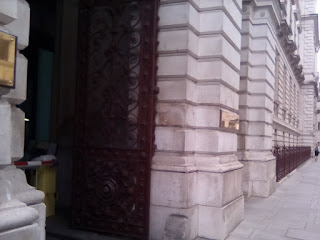“
Mycroft
has his rails and he runs on them. His Pall Mall lodgings, the
Diogenes Club, Whitehall—that is his cycle” - Sherlock Holmes
[BRUC]
As part of their
‘London Weekend 2019’, the
Sherlock
Holmes Society of London were proposing to retrace the
steps of Holmes Senior, from his lodgings in Pall Mall to the Foreign
and Commonwealth Office (FCO) on King Charles Street, where on
occasions he “was the British Government” [BRUC]. Places were
limited, but I managed to get one. The meeting point was at 2pm sharp
at Waterloo Place, St. James’s, just next to the Duke of York
column situated just above the steps down to The Mall (which Sherlock
and Mary rode down on a motorcycle in
‘The
Empty Hearse’). Having a few minutes to spare, I
managed to wander down Pall Mall to take photos of the former
sites of the Baldwin Club (one of the Card Clubs frequented by the
Honourable Ronald Adair in
‘The
Empty House’) and the Junior Carlton Club (believed
by Dr Seth Alexander Thévoz, author of
‘Club
Government’, to be the Diogenes Club). I also passed
the former site of ‘Cox & Co’ which held Watson’s battered
dispatch box containing details of unrecorded cases, as outlined in
‘The
Problem of Thor Bridge’.




Returning to the column
, which is situated next to the building that acts as the Diogenes
Club in ‘Sherlock’, I joined a small group, with five minutes to
spare.


Following a brief
introduction by the organiser of the walk, Marcus Geisser, BSI, we
strode off down the stairs, past St. James’ Park and Horse Guards
Parade (where preparations were being made for a ‘Trooping The
Colour’ dress rehearsal, the next day. After around ten minutes, we reached the
FCO, taking the likely route that Mycroft would have done on a daily
basis. The Foreign and Commonwealth Office occupies a building which
originally provided premises for four separate government
departments: the Foreign Office, the India Office, the Colonial
Office, and the Home Office. Construction on the building began in
1861 and finished in 1868, and it was designed by the architect
George Gilbert Scott. Its architecture is in the Italianate style;
Scott had initially envisaged a Gothic design, but Lord Palmerston,
then Prime Minister, insisted on a classical style.


Here a one hour’s
private tour of the building had been arranged for our group.
Photography was prohibited in some areas of the building on security
grounds, but I was able to take photos of several meeting rooms which
may have been frequented by Mycroft, and a ministerial room which he
may also have known. We also got to look out onto Downing Street and
Numbers 10 & 11. The guide was very enthusiastic, and we ended up
spending an hour-and-a-half wandering the FCO corridors.
We then retraced our steps at speed to the
Athenaeum Club, situated at 107 Pall Mall, one of the prime candidates for The Diogenes Club.
"
There
are many men in London, you know, who, some from shyness, some from
misanthropy, have no wish for the company of their fellows. Yet they
are not averse to comfortable chairs and the latest periodicals. It
is for the convenience of these that the Diogenes Club was started,
and it now contains the most unsociable and unclubable men in town”
– Sherlock Holmes [GREE]
Having
gained entry through one of our party who is a member, we moved to
the basement where an exhibition had been created for us by the Club
Archivist, relating to Watson’s Literary Agent, Sir Arthur Conan
Doyle’s membership of this prestigious club, including his
signature in the register and details of dinners that he was present
at, one also including
Norman
Hapgood, the editor of ‘Collier’s Weekly’ in
which Holmes was resurrected soon after the dinner.
The
afternoon was concluded with tea and biscuits, and a visit to the
Drawing Room, one of the few areas of the Club where non-members are
allowed.


 Our client, Mr. Robert Ferguson, of Ferguson and Muirhead, tea brokers, of Mincing Lane, has made some enquiry from us in a
communication of even date concerning vampires. As our firm specializes entirely upon the
assessment of machinery the matter hardly comes within our purview, and we have therefore
recommended Mr. Ferguson to call upon you and lay the matter before you. We have not
forgotten your successful action in the case of Matilda Briggs.
Our client, Mr. Robert Ferguson, of Ferguson and Muirhead, tea brokers, of Mincing Lane, has made some enquiry from us in a
communication of even date concerning vampires. As our firm specializes entirely upon the
assessment of machinery the matter hardly comes within our purview, and we have therefore
recommended Mr. Ferguson to call upon you and lay the matter before you. We have not
forgotten your successful action in the case of Matilda Briggs. We are, sir,
We are, sir,



















































